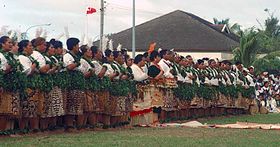Lakalaka
- Lakalaka
-
| Lakalaka, danses et discours chantés du Tonga * |
|
|
|

lakalaka pour le 70e anniversaire du roi du Tonga. La princesse Pilolevu Tuita est le vahenga.
|
| Pays * |
 Tonga Tonga |
| Région * |
Asie et Pacifique |
| Liste |
Liste représentative |
| Fiche |
00072 |
| Année d’inscription |
2008 |
| Année de proclamation |
2003 |
|
* Descriptif officiel UNESCO |
modifier  |
Le lakalaka est la danse traditionnelle nationale du Tonga pratiquée lors des cérémonies importantes comme le couronnement du roi et l’anniversaire de la constitution. « Lakalaka, danses et discours chantés du Tonga » a été proclamé en 2003 puis inscrit en 2008 par l'UNESCO sur la liste représentative du patrimoine culturel immatériel de l’humanité[1].
Description
La tradition est apparue au XIXe siècle à partir de la danse me'elaufola. Le terme lakalaka signifie en tongien « faire des pas rapides ou prudents ». Pendant une trentaine de minutes plusieurs centaines de personnes dansent en rythme en deux groupes, les hommes à droite et les femmes à gauche. Les danseurs frappent des mains et chantent, souvent accompagnés par un chœur[1]. Les personnes sont placés suivant leur rang social et entre les hommes et les femmes est placé le vahenga, une personne de haut rang qui porte souvent un costume unique[2].
Les danseurs sont habillés de façon traditionnelle avec des chaînes de cheville, des bracelets, des colliers et un tekiteki, une coiffe de plume[2].
Notes et références
Wikimedia Foundation.
2010.
Contenu soumis à la licence CC-BY-SA. Source : Article Lakalaka de Wikipédia en français (auteurs)
Regardez d'autres dictionnaires:
Lakalaka — Lakalaka, danzas y discursos cantados de Tonga Patrimonio Cultural Inmaterial Nombre descrito en la Lista del Patrimonio Inmaterial … Wikipedia Español
Lakalaka — zum 70. Geburtstag des tongaischen Königs Taufaʻahau Tupou IV. 1988 Lakalaka sind zeremonielle Gruppentänze in Tonga, bei denen mehrere hundert Personen beteiligt sein können. Charakteristisch für die Tänze ist, dass die Tänzer die meiste Zeit… … Deutsch Wikipedia
Lakalaka — The lakalaka (walking briskly) is a Tongan group dance where the performers are largely standing still and make gestures with their arms only. It is considered as the national dance of Tonga and part of the intangible human heritage. It is the… … Wikipedia
Лакалака — Исполнение танца лакалака. Лакалака (тонг. lakalaka; в переводе «двигаться оживлённо или с осторожностью»[1] … Википедия
Anexo:Lista Representativa del Patrimonio Cultural Inmaterial de la Humanidad — Mapa que muestra la distribución de las obras maestras del patrimonio oral e inmaterial de los Estados Miembros de la Unesco a partir del 2005. La Lista Representativa del Patrimonio Cultural Inmaterial de la Humanidad (también llamada Lista… … Wikipedia Español
Ma'ulu'ulu — The māokinauluokinaulu is a traditional Tongan dance, performed by a group of seated man and women; stylistically, the dance form is a direct successor of the ancient Tongan okinaotuhaka having been synthesized with the Samoan māuluulu which was… … Wikipedia
Sangone — Sāngone (Sāmoan sā = tribe, Fijian (n)gone = child), was the name of a turtle from divine origin and featuring in Tongan myths about the Tuokinai Tonga king named Tuokinaitātui in the beginning of the 12th century AD. Part of the history features … Wikipedia
Tautoga — The tautoga (IPA pronunciation: /tɔʊtɔŋɑ/) is considered the most formal and restrained style of Rotuman dance, usually seen performed in large festivities or ceremonies (called kato aga , a term summing up all traditional Rotuman ceremonies), or … Wikipedia
Tonga — Este artículo trata sobre el país insular del Pacífico. Para el pueblo en Nanumanga (Tuvalu), véase Tonga (Tuvalu). Pule anga Fakatu i o Tonga Kingdom of Tonga Reino de Tonga … Wikipedia Español
Тонга — У этого термина существуют и другие значения, см. Тонга (значения). Королевство Тонга Puleʻanga Fakatuʻi ʻo Tonga Kingdom of Tonga … Википедия


 Tonga
Tonga
